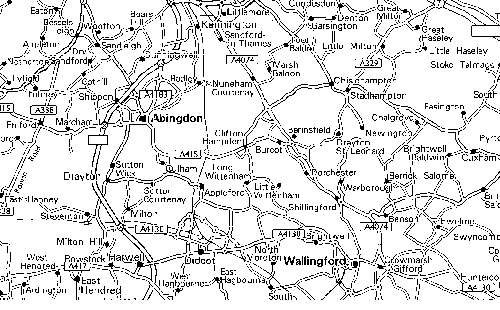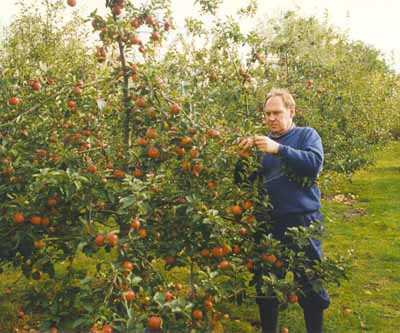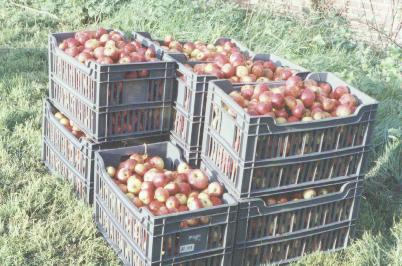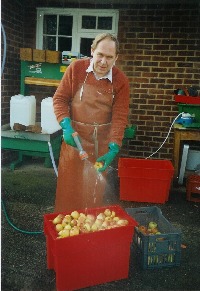 Location
Location Location
LocationMy orchard is between Abingdon and Wallingford in South Oxfordshire. It's situated at 1 degree 11 minutes West, 51 degrees 38 minutes North, and is 250 ft above sea level. It lies on a slope inclined at about 5 degrees to the northwest, on a calcareous soil known as 'Upper Greensand', which is a form of weathered Chiltern chalk / clay derived from the hills known as the Wittenham Clumps. The villages of Long and Little Wittenham are shown just below centre on the map.

My orchard land was previously grass or arable (wheat / barley) and
it
was ploughed in the spring of 1988 prior to fencing and seeding
with a ryegrass / fescue / timothy / white clover 'sheep' mix.
 Windbreaks
Windbreaks
Because the site is exposed to the prevailing westerly wind and
there is no higher ground in that direction for about 60 miles,
I planted a windbreak of 'Bowles hybrid' willows Salix cinerea
x caprea early that Spring. These were long poles (typically
4 - 6 ft) which were set in the ground 18 inches apart through
a black polythene mulching strip. They took readily that summer,
although in many ways the site is rather too dry for them and
some have now died back. I have trimmed them on a three-year rotation
but now that the orchard itself is established I may eventually
replace the willows with something more appropriate. Both Italian
alder (Alnus cordata) and beech (Fagus sylvatica)
do extremely well here and I may consider either of those.
 Planting
PlantingThe trees were individually pit-planted in the autumn / winter of 1988 into 2 ft holes (worked with bonemeal and hoof-and-horn). They were staked with short stakes (tied with old tights) and protected with hare / rabbit guards (which is essential here, and I still have major problems with rabbits nibbling the 10-year old trunks). They were top-dressed with dried blood after planting.
The planting stock itself was obtained from Scott's Nurseries
of Merriott, near Martock in Somerset, which is one of the premier
fruit tree nurseries in England. They were budded to order for
me in August 1987 onto MM106 rootstock - the scion-wood was derived
from virus-free Long Ashton stock.
 The picture here (taken by Roy Bailey of Lambourn
Valley Cider)
shows me examining the fruit on a Dabinett tree in autumn 1997,
nine years after planting. They are grown on a centre-leader system
as described in Part 2 of 'The Science of
Cidermaking'.
The trees are now about 12 ft high and most have been cropping
for several years. They are grown essentially organically and
have had no input of fertilisers since planting, except a light
top-dressing of Growmore to encourage them in their second spring.
I run ten chickens in the orchard but how much they contribute
to fertility I'm not clear! The trees show no signs of nitrogen
or mineral deficiency at present and I intend to maintain them
in a low-input system, not least because it's best for the style
of cidermaking which I wish to do. I've felt no need to spray
against pests and diseases although I do have a significant 'brown
rot' problem which affects certain cultivars more than others.
The cure for that, in any case, is via orchard hygiene
rather than sprays!
The picture here (taken by Roy Bailey of Lambourn
Valley Cider)
shows me examining the fruit on a Dabinett tree in autumn 1997,
nine years after planting. They are grown on a centre-leader system
as described in Part 2 of 'The Science of
Cidermaking'.
The trees are now about 12 ft high and most have been cropping
for several years. They are grown essentially organically and
have had no input of fertilisers since planting, except a light
top-dressing of Growmore to encourage them in their second spring.
I run ten chickens in the orchard but how much they contribute
to fertility I'm not clear! The trees show no signs of nitrogen
or mineral deficiency at present and I intend to maintain them
in a low-input system, not least because it's best for the style
of cidermaking which I wish to do. I've felt no need to spray
against pests and diseases although I do have a significant 'brown
rot' problem which affects certain cultivars more than others.
The cure for that, in any case, is via orchard hygiene
rather than sprays!
 Mowing
Mowing
In the first few years, the grass in the orchard grew vigorously
and needed mowing several times per season, always leaving the
mowings on the ground to avoid potassium deficiency. In the last
two or three years, however, I've only really needed to mow once
per season (and to cut out patches of nettle and dock which creep
in where the chickens scratch). I think this is mostly due to
increasing competition from the growing trees, but may owe a little
to grazing by the feral rabbits. They are a nuisance and nibble
the tree barks severely in winter, so each trunk is now protected
with wire mesh to keep them off.
 Thinning
Thinning
There were just 33 trees (3 each of 11 cultivars) originally planted
at 10 ft spacing in rows 15 ft apart, based on my best estimate
of the site fertility. In practice I underestimated it, and that
spacing is now too close for several of the stronger growing cultivars.
Although I do a certain amount of branch thinning and 'cutting
up' every winter, I have now been forced to remove a few trees
because there's just too much wood! This leads to poor air circulation,
difficulty at harvest time, and doesn't help my brown rot problem
either. In hindsight, I should have planted the trees on a 'quincunx'
arrangement which allows for tree removal in later years -
unfortunately
I used a rectangular grid which means that where I've had to remove
trees (in winter 97/98) there are now gaps. But since these were
the most spreading trees their neighbours will soon fill the space!
 Yields
Yields
For the last three seasons I've been getting about half a ton
of fruit (400 - 500 kg) from about one-sixth of an acre. This
grosses up to 3 tons per acre which I regard as pretty fair from
a low-input system. I can't handle much more fruit than that on
a domestic scale and in any case this is a hobby where I'm more
interested in quality than in quantity!
 Which cultivars?
Which cultivars?The table below shows you the types of trees I'm growing, with any appropriate comments added. The original mix was intended to be a balance to give a good blended cider - in practice this has worked out fairly well. I wouldn't choose Frederick again, though, due to its desperate susceptibility to brown rot, and Crimson King is just too massive a tree. Medaille d'Or is a great late bittersweet but on this soil its brittleness is a serious drawback. This area isn't a traditional cider growing region and so it's difficult to know these things until you try them in your own location!
|
|
|
|
|---|---|---|
| Kingston Black | Bittersharp | Shy cropper. A bit scab prone and somewhat affected by brown rot, hence not storing well (red fruit), |
| Harry Masters Jersey | Bittersweet | A bit scab prone but otherwise fine (red fruit). |
| Broxwood Foxwhelp | Bittersharp | Matures 3 weeks before the others. I was persuaded into this one by Ray Williams at Long Ashton who'd just released a virus-cleaned version in 1987 when I was selecting stock! (red/yellow striped fruit) |
| Sweet Coppin | Sweet | Large fruits. Has now gone biennial (1997 was off!) (green fruit). |
| Frederick | Sharp | Very untidy reflexed growth and most fruits are badly affected with brown rot on the tree, hence practically unusable. One tree removed in 1998 due to overcrowding (red/russet fruit). |
| Stoke Red | Bittersharp | Very twiggy and now biennial (1997 was its first year to crop and 1998 is now off!). Fruits are small, but excellent for single variety or a blend with Kingston Black (bright red fruit). |
| Yarlington Mill | Bittersweet | Cropped first in 1997 (red fruit). |
| Crimson King | Sharp | Large tree and large fruits. Quite prone to brown rot. Had to remove 2 out of the original 3 trees in 1998 due to overcrowding (red/yellow fruit). |
| Dabinett | Bittersweet | Compact and reliable. Is not yet biennial (red fruit). |
| Medaille d'Or | Bittersweet | Flowers too late for cross-pollination but somehow sets fruit! Wood is extremely brittle and all 3 trees have lost their centre leaders due to wind. Now growing as bush / tabletops! (russet yellow fruit) |
| Le Bret (false Sweet Alford) |
Sweet | Very scab prone, with some mildew. Not doing very well ?magnesium deficiency? (red/yellow fruit) |
 Harvesting
Harvesting
 In
general, I don't harvest the main bulk
of fruit until it's absolutely ripe, which means that about 50%
of it has fallen on the orchard floor. Before that I generally
make at least one preliminary pass to collect the windfalls, sorting
and discarding any rots and damaged fruit that won't store. These
windfalls are generally pressed within a week or two of collection,
whereas the main bulk of fruit may be stored for a month or more
before processing.
In
general, I don't harvest the main bulk
of fruit until it's absolutely ripe, which means that about 50%
of it has fallen on the orchard floor. Before that I generally
make at least one preliminary pass to collect the windfalls, sorting
and discarding any rots and damaged fruit that won't store. These
windfalls are generally pressed within a week or two of collection,
whereas the main bulk of fruit may be stored for a month or more
before processing.
The trees were originally chosen to have similar harvest times to each other (midseason) so that I could blend the fruit before milling and pressing. This has generally worked although the Broxwood Foxwhelp (which was not on my original list) does come on about three weeks earlier than the rest.
 So
around about the last week in September we collect up all the
Broxwood Foxwhelp together with any early windfalls and this usually
constitutes the first pressing of cider. The main bulk of fruit
will not be collected until the middle to end of October, and
is usually pressed in a couple of sessions from midNovember
into December.
So
around about the last week in September we collect up all the
Broxwood Foxwhelp together with any early windfalls and this usually
constitutes the first pressing of cider. The main bulk of fruit
will not be collected until the middle to end of October, and
is usually pressed in a couple of sessions from midNovember
into December.
All the fruit is graded and rots removed at
the time of harvest. I usually try to wash off the bulk of the
orchard mud (if any) at this stage. The fruit is then stored in
open plastic crates outdoors until it's time for pressing. The
day before use, the fruit is regraded to discard new rots
and then washed with water, crate by crate, to remove all adherent
mud, leaves, twigs, insects etc. The picture shows some fruit
'ready to go'!
This page last updated on 23 August 1998